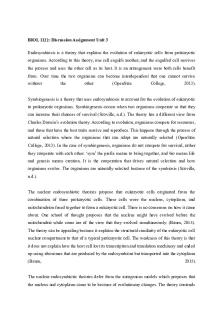BIOL 1122 UNIT 3 DF Assignment Number 6 PDF

| Title | BIOL 1122 UNIT 3 DF Assignment Number 6 |
|---|---|
| Author | Timmy Sarah |
| Course | Biology 2 for Health Studies Majors |
| Institution | University of the People |
| Pages | 3 |
| File Size | 67.6 KB |
| File Type | |
| Total Downloads | 25 |
| Total Views | 131 |
Summary
UNIT 3 BIOL 1122 DISCUSSION ASSIGNMENT 6...
Description
BIOL 1122: Discussion Assignment Unit 3 Endosymbiosis is a theory that explains the evolution of eukaryotic cells from prokaryotic organisms. According to this theory, one cell engulfs another, and the engulfed cell survives the process and uses the other cell as its host. It is an arrangement were both cells benefit from. Over time the two organisms can become interdependent that one cannot survive without
the
other
(OpenStax
College,
2013).
Symbiogenesis is a theory that uses endosymbiosis to account for the evolution of eukaryotic to prokaryotic organisms. Symbiogenesis occurs when two organisms cooperate so that they can increase their chances of survival (Scoville, n.d.). The theory has a different view from Charles Darwin’s evolution theory. According to evolution, organisms compete for resources, and those that have the best traits survive and reproduce. This happens through the process of natural selection where the organisms that can adapt are naturally selected (OpenStax College, 2013). In the case of symbiogenesis, organisms do not compete for survival, rather they cooperate with each other. ‘sym’ the prefix means to bring together, and bio means life and genesis means creation. It is the cooperation that drives natural selection and how organisms evolve. The organisms are naturally selected because of the symbiosis (Scoville, n.d.).
The nuclear endosymbiotic theories propose that eukaryotic cells originated from the combination of three prokaryotic cells. These cells were the nucleus, cytoplasm, and mitochondrion fused together to form a eukaryotic cell. There is no consensus on how it came about. One school of thought proposes that the nucleus might have evolved before the mitochondria while some are of the view that they evolved simultaneously. (Baum, 2015). The theory can be appealing because it explains the structural similarity of the eukaryotic cell nuclear compartment to that of a typical prokaryotic cell. The weakness of this theory is that it does not explain how the host cell lost its transcription and translation machinery and ended up using ribosomes that are produced by the endosymbiont but transported into the cytoplasm (Baum,
2015).
The nuclear endosymbiotic theories defer from the autogenous models which proposes that the nucleus and cytoplasm came to be because of evolutionary changes. The theory contends
that organelles found in the eukaryotic cells such as the Golgi apparatus, vacuoles, lysosomes, and the endoplasmic reticulum all came from a single prokaryote ancestor. The infoldings of the prokaryote plasma membrane caused the compartmentalization of functions. The theory suggests that the mitochondria and chloroplasts within the prokaryotic cell evolved by the separation of the vesicles or plasmids of DNA (Sites.google.com, n.d.).
The theory that seems to be the most plausible is the nuclear endosymbiotic theories theory. The theory suggests that eukaryotic cells originated from the combination of three prokaryotic cells. The theory explains the structural similarities of the eukaryotic cell and the typical prokaryotic cell. I think that is a better explanation than the one given by the autogenous model which is of the view that all the organelles came from a single prokaryote ancestor. Cell merging to became one cell which increases the chances of it being naturally selected
is
probable.
References
Baum, D. A. (2015). A comparison of autogenous theories for the origin of eukaryotic cells. American
journal
of
botany.
https://bsapubs.onlinelibrary.wiley.com/doi/pdf/10.3732/ajb.1500196#:~:text=Nuclear %20endosymbiotic%20theories%20hold%20that,in%20a%20single%20prokaryotic %20lineage.&text=vesicles%20within%20the%20original%20cell%20body.
OpenStax College. (2013). Biology [E-book]. http://cnx.org/contents/[email protected]:1/
Scoville, H. (n.d.). Heather Scoville, M.A. ThoughtCo. Retrieved September 20, 2020, from https://www.thoughtco.com/heather-scoville-1224419
Sites.google.com. (n.d.). Autogenous Theory. Retrieved September 21, 2020, from https://sites.google.com/site/theendosymbiotictheory/autogenous-theory
Taylor, F. (1976). Autogenous Theories for the Origin of Eukaryotes. Taxon, 25(4), 377-390. doi:10.2307/1220521
629 words...
Similar Free PDFs

BIOL 1122 UNIT 1 DF Number 1
- 2 Pages

BIOL 304 UNIT 3 Lectures
- 135 Pages

BIOL 1301 Unit 6 - Self Quiz
- 3 Pages

BIOL 112- Unit 2 (Lec 6-9)
- 16 Pages

BIOL 1301 Unit 6 - Graded Quiz 2
- 16 Pages

Written Assignment Unit 6
- 8 Pages

Unit 6 - Written Assignment
- 4 Pages

Discussion assignment unit 6
- 2 Pages
Popular Institutions
- Tinajero National High School - Annex
- Politeknik Caltex Riau
- Yokohama City University
- SGT University
- University of Al-Qadisiyah
- Divine Word College of Vigan
- Techniek College Rotterdam
- Universidade de Santiago
- Universiti Teknologi MARA Cawangan Johor Kampus Pasir Gudang
- Poltekkes Kemenkes Yogyakarta
- Baguio City National High School
- Colegio san marcos
- preparatoria uno
- Centro de Bachillerato Tecnológico Industrial y de Servicios No. 107
- Dalian Maritime University
- Quang Trung Secondary School
- Colegio Tecnológico en Informática
- Corporación Regional de Educación Superior
- Grupo CEDVA
- Dar Al Uloom University
- Centro de Estudios Preuniversitarios de la Universidad Nacional de Ingeniería
- 上智大学
- Aakash International School, Nuna Majara
- San Felipe Neri Catholic School
- Kang Chiao International School - New Taipei City
- Misamis Occidental National High School
- Institución Educativa Escuela Normal Juan Ladrilleros
- Kolehiyo ng Pantukan
- Batanes State College
- Instituto Continental
- Sekolah Menengah Kejuruan Kesehatan Kaltara (Tarakan)
- Colegio de La Inmaculada Concepcion - Cebu







